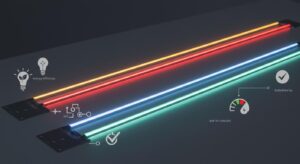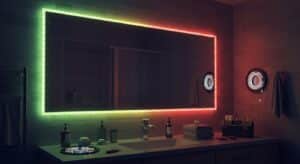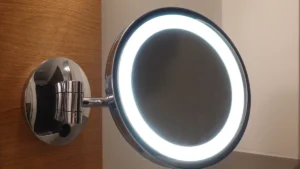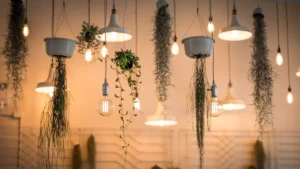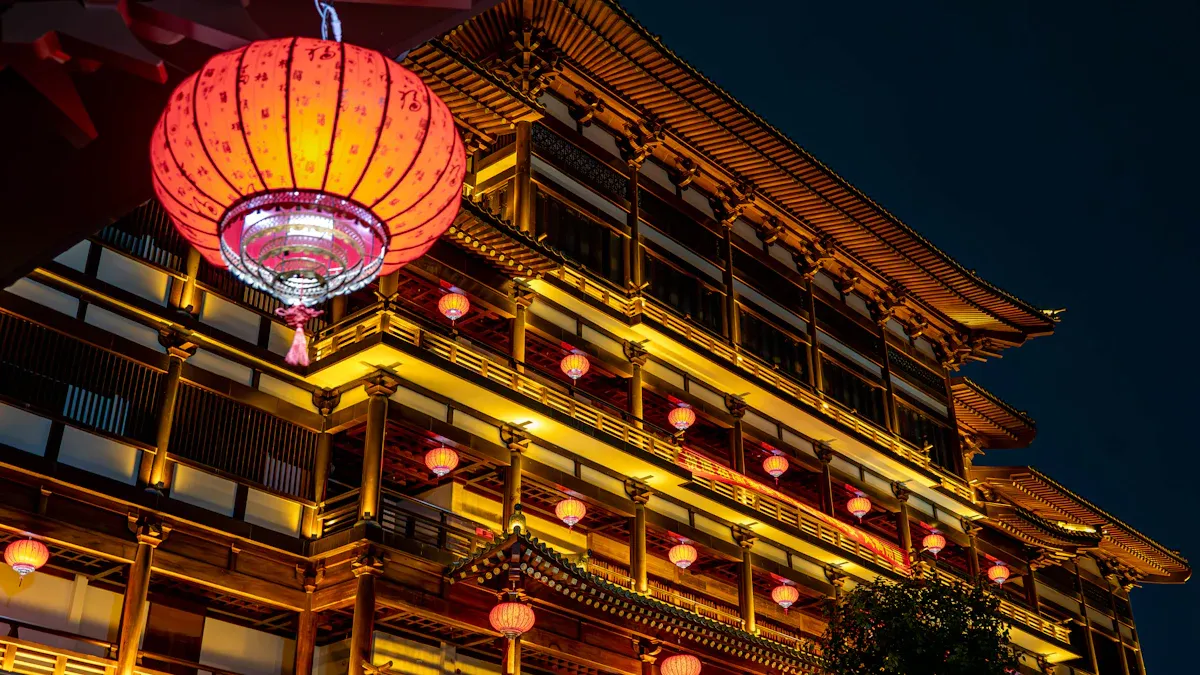
As you consider lighting choices for 2025, you will notice a significant shift towards LED lights in strips. These are becoming increasingly popular, particularly in homes and businesses. By 2025, 51.4% of outdoor lights will be LED. For indoor lights, the figure stands at 29.8%. While traditional lighting remains important, LED lights in strips offer numerous advantages. They consume less energy and have a longer lifespan. Understanding the differences in energy consumption, cost, environmental impact, and performance will assist you in making informed decisions for your lighting requirements.
Key Takeaways
LED strip lights use up to 80% less energy than regular bulbs. This means lower electricity bills.
Even though LED strip lights cost more at first, they can last up to 50,000 hours. This saves money on replacements later.
Using LED lights helps lower your carbon footprint. They use less energy and are easier to recycle.
LED strip lights are flexible. You can use them in many places, like homes and businesses. They improve looks and usefulness.
Traditional lighting might be cheaper at first. However, it needs replacing more often. This makes it less cost-effective over time.
Efficiency
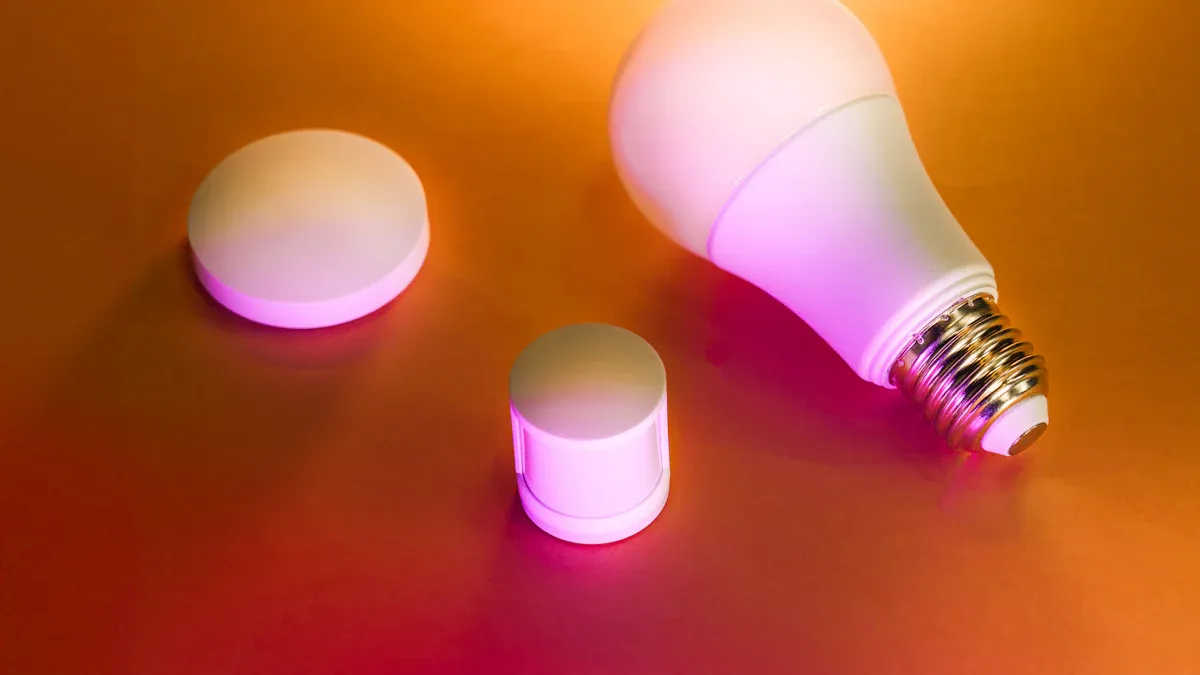
LED Lights in Strips
LED lights in strips are very energy efficient compared to traditional lights. These lights use special technology that changes electrical energy into light with little heat loss. Because of this, LED strip lights can be up to 80% more energy-efficient than regular incandescent bulbs. This efficiency means you save a lot of power, making them a great choice for homes and businesses.
Here are some benefits of LED strip lights:
They can last for up to 50,000 hours, so you won’t need to replace them often.
They let heat escape better, which helps their energy efficiency.
You will have lower electricity bills because they use less energy.
To show the differences in energy use, here’s a comparison of different lighting types:
Lighting Type | Energy Consumption Comparison |
|---|---|
LED | 80-90% less than incandescent |
LED | 30% less than fluorescent |
LED (4-foot tube) | 44% more efficient than CFLs |
Traditional Lighting Efficiency
On the other hand, traditional lights like incandescent and fluorescent bulbs are not as energy efficient. For example, incandescent bulbs usually have a light output of only 10-17 lumens per watt, while compact fluorescent lamps (CFLs) give off 35-60 lumens per watt. This means they use more energy and cost more to run over time.
Here’s a look at the light output of common traditional lighting sources:
Lighting Source | Luminous Efficacy (lm/W) |
|---|---|
Incandescent bulb | 10-17 |
Halogen bulb | 15-20 |
Compact Fluorescent Lamp | 35-60 |
Fluorescent lamp | 16-100 |
Switching to LED strip lights can save you a lot on your electricity bills. For instance, a regular 60-watt incandescent bulb uses 600 watt-hours in 10 hours, while an LED strip light only uses 90-120 watt-hours in the same time. This means LED strip lights can use up to 85% less electricity than incandescent bulbs, which can really lower your yearly energy costs.
Cost Analysis
Initial Costs of LED Light Strip
When you look at the starting costs of LED strip lights, you might see they usually cost more than traditional lights. But this extra money spent at first pays off later because they save energy and last longer. Here’s a simple list of what affects the cost differences:
Factor | Die led-landing | Traditional Lighting |
|---|---|---|
Initial Cost | Higher upfront cost | Lower initial cost |
Energy Efficiency | Uses 75% less energy than incandescent bulbs | Less energy-efficient, wastes electricity as heat |
Lifespan | Up to 50,000 hours | Incandescent: ~1,000 hours; Fluorescent: ~8,000 hours |
Maintenance Costs | Lower due to longer lifespan | Higher due to frequent replacements |
Adaptability | Highly customisable | Limited customisation options |
LED strip lights turn almost all electricity into light. Traditional lights waste a lot of energy as heat. This efficiency means you save a lot of money over time.
Long-term Cost Considerations
In the long run, LED strip lights are a better choice for your wallet. Even though they cost more at first, they save you money because they last longer and need fewer replacements. For example, LED bulbs last about 25 times longer than regular bulbs. This means you spend less on replacements and upkeep.
Think about these points for long-term savings:
LED bulbs use 90% less energy.
The average yearly cost of LED bulbs is about £1.70 for five hours of use each day.
You could save thousands of pounds on energy bills each year.
The time it takes to get your money back from buying LED strip lights is also good. For example, a 20 W LED light has a payback period of about 4.01 years. After this time, you will start to see savings from lower energy costs.
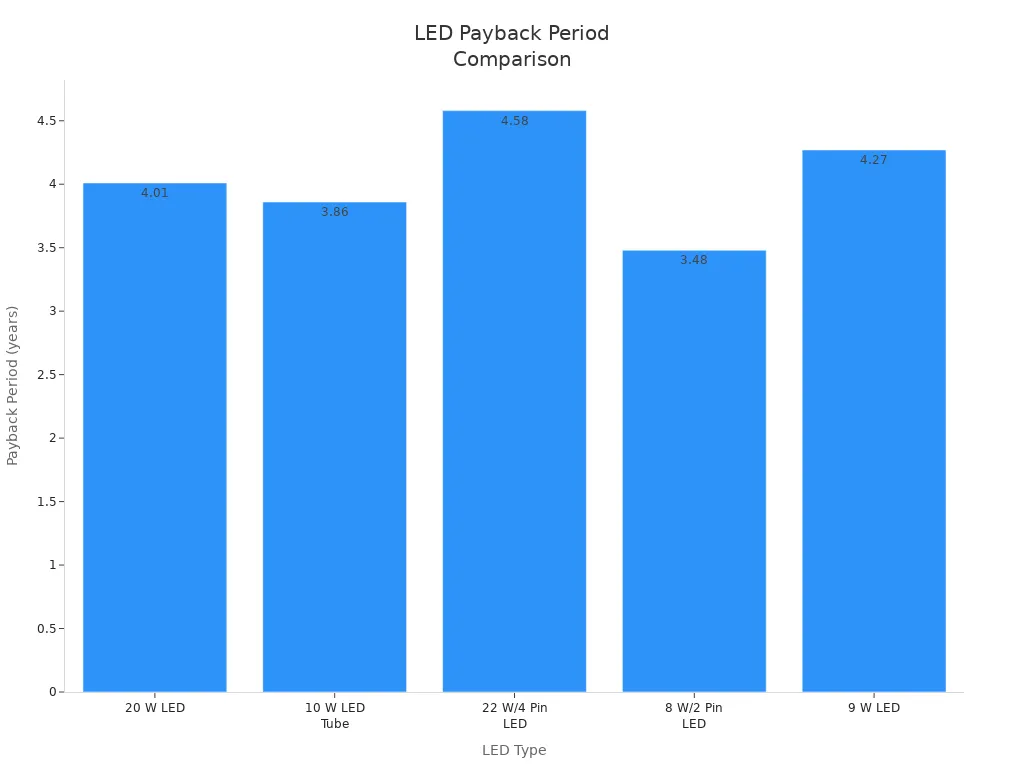
As the global LED lighting market keeps growing, with a projected growth rate of 10.53%, the price of LED technology is likely to go down even more. This trend, along with the end of traditional fluorescent lights due to new rules, makes LED strip lights a better choice for homes and businesses.
Environmental Impact
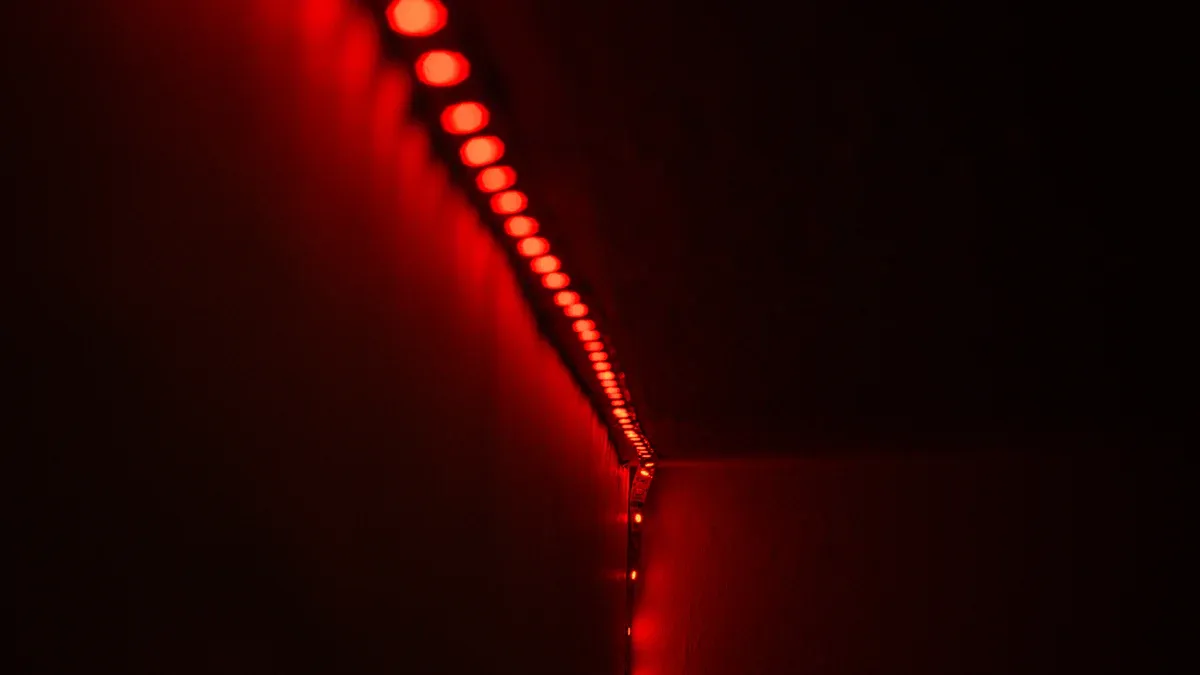
Sustainability of LED Neon Rope Lights
LED neon rope lights are a great choice for the environment. They use less energy than regular neon lights. This helps to lower your carbon footprint. Here are some important points about their sustainability:
LED neon rope lights are energy-efficient and use less power.
They last longer, so you do not need to replace them often.
These lights are tougher and create less heat, which saves energy.
The average carbon footprint for making and using LED strip lights is about 17.75 kg CO2e. This number is between 10.50 and 25.00 kg CO2e. This makes LED strip lights a better choice for the environment than traditional lighting.
Environmental Concerns with Traditional Lighting
Traditional lighting, like incandescent and fluorescent bulbs, has many environmental problems. Here are some issues to think about:
Compact fluorescent light bulbs (CFLs) have about 5 milligrams of mercury. This can be dangerous if the bulbs break or are thrown away wrongly.
Used fluorescent lamps can let out toxic mercury and other heavy metals like cadmium or lead if not thrown away properly.
Incandescent bulbs cause environmental problems mainly because they use a lot of energy. This leads to more carbon emissions from making electricity.
Recycling rates for traditional lighting are also worrying. Traditional lamps, especially fluorescent ones, need special recycling because of their harmful parts. On the other hand, LED bulbs can be recycled easily. About 90% of their parts can be recycled. However, you should take LED bulbs to special recycling places. They should not go in regular recycling bins.
By choosing LED strip lights, you save energy and help create a better future for the environment.
Durability
Lifespan of LED Strip Lights
LED strip lights can last a long time, about 50,000 hours on average. If you use them for 10 hours a day, they will work well for over 13 years. Even if you keep them on all the time, like 24/7, they can still last around 5.5 years. After they reach their lifespan, they might still work but won’t be as bright.
LED strip lights last long because of a few reasons:
They are made from strong materials that don’t lose brightness quickly.
They have good heat management systems that help get rid of extra heat.
They have built-in current regulators that keep the power steady.
These features make them tough, which is great for busy places where things might break easily.
Lifespan of Traditional Lighting
On the other hand, traditional lights like incandescent and fluorescent bulbs do not last as long. Here’s how their lifespans compare:
Bulb Type | Typical Lifespan (Hours) | Approximate Lifespan (Years) |
|---|---|---|
Incandescent | 1,000 | 1 |
Halogen | 2,000 | 1.5 |
CFL | 7,000 – 10,000 | 6 – 9 |
Because traditional bulbs last a shorter time, you will need to change them often. For example, you would need 20-50 replacements of incandescent bulbs to equal the lifespan of just one LED bulb. This means you spend more on maintenance, making traditional lighting cost more over time.
Applications
Use Cases for LED Lights in Strips
LED strip lights are very flexible. They can be used in many places. You can see them in homes and businesses. Here are some common uses:
Residential Settings: LED strip lights are often found in living rooms, bedrooms, and kitchens. They give soft lighting and can be placed under cabinets or behind TVs for a stylish look.
Retail Spaces: Shops use LED strips to show off products and improve displays. This helps attract more customers and boosts sales.
Event & Stage Lighting: For weddings and concerts, LED strip lights create exciting atmospheres. They can change with the music, making the visuals even better.
Commercial and Architectural Projects: Companies use LED strip lights in their branding. They help create engaging experiences for customers in larger spaces.
You can cut and adjust LED strips to fit any area, allowing for full customisation. They are also energy-efficient and eco-friendly, using much less energy than traditional lights.
Advantage | Description |
|---|---|
Adaptability | LED strips can be cut and adjusted to fit any space, allowing for complete customisation. |
Energy efficiency and sustainability | They consume significantly less energy than traditional light sources, reducing environmental impact and costs. |
Use Cases for Traditional Lighting
Even with the growth of LED lights, traditional lighting is still useful in some situations. Here are some reasons to choose traditional lighting:
Key Performance Reason | Description |
|---|---|
Simplicity and Reliability | Traditional lighting is easy to use. You can plug them in without needing any special skills. They turn on right away, giving light when you need it, especially in emergencies. |
Lower Initial Cost | Traditional bulbs usually cost less than £5, making them affordable for people on a budget. This lower price encourages homeowners to pick regular lighting over pricier options. |
User-Friendly Experience | Traditional lighting needs very little setup. Anyone can change a bulb without needing apps or settings, making it great for homes with many users. |
In conclusion, both LED strip lights and traditional lighting have their own good and bad points.
Advantages | Disadvantages |
|---|---|
Save energy | Not clearly mentioned |
Last a long time | |
Good for the environment | |
Can be designed and controlled easily | |
Produce less heat | |
Long-lasting | |
Light and simple to set up | |
Safe to use (no explosion risk) | |
Need less care |
When picking between these choices, think about things like energy saving, how long they last, and how easy they are to install. LED strip lights are more efficient and last longer, making them a smart choice over time. Traditional lighting might be better for those who want lower starting costs and ease of use. In the end, your own needs and likes will help you choose the best lighting for your area.
FAQ
What are LED strip lights?
LED strip lights are bendable boards with LED lights on them. You can cut them to fit and use them for many things, like accent lighting, task lighting, or decoration.
How long do LED strip lights last?
LED strip lights usually last around 50,000 hours. This long life means you won’t have to change them often, making them a money-saving lighting choice.
Are LED strip lights energy-efficient?
Yes, LED strip lights are very energy-efficient. They use up to 80% less energy than regular incandescent bulbs, which helps lower your electricity bills.
Can I use LED strip lights outdoors?
Yes, you can! Many LED strip lights are made for outdoor use. Just make sure to pick weather-resistant ones to handle rain and sun.
How do I install LED strip lights?
Installing LED strip lights is easy. First, clean the surface, then peel off the sticky backing, and press the strip in place. For more complicated setups, you might need connectors or a power supply.
See Also
Selecting The Perfect LED Strip Lights For Linear Lighting
Best LED Strip Lights Of 2024: A Price And Feature Review
5V Versus 12V LED Strips: Which One To Choose?
